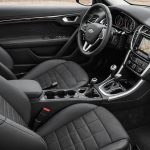Mastering Dual-Clutch Transmissions: Tips for Achieving Smoother Shifts in the UK
Understanding Dual-Clutch Transmissions
When it comes to modern automotive technology, few innovations have made as significant an impact as the dual-clutch transmission (DCT). This sophisticated gearbox combines the efficiency of a manual transmission with the convenience of an automatic, making it a favorite among performance and sports car enthusiasts. But what exactly is a DCT, and how can you master its use to enhance your driving experience?
A DCT, also known as a DSG (Direct Shift Gearbox) in some Volkswagen Group vehicles, uses two separate clutches for odd and even gear sets. This design allows for nearly seamless gear changes, as one clutch engages the current gear while the other pre-selects the next gear. This mechanism results in quicker acceleration and a smoother driving experience compared to traditional manual or automatic transmissions[5].
Topic to read : Essential Tips for Caring for Your Retractable Hardtop Convertible in the UK”s Changing Weather
How DCT Gearboxes Operate
To fully appreciate the benefits of a DCT, it’s essential to understand its operation. Here’s a breakdown of how it works:
- Dual Clutches: The DCT system employs two clutches, one for the odd gears (1, 3, 5, etc.) and one for the even gears (2, 4, 6, etc.). This setup enables the gearbox to pre-select the next gear before the current gear is disengaged, reducing the time it takes to shift gears[4].
- Gear Changes: The onboard computer of the vehicle constantly monitors various parameters such as speed, engine load, and accelerator position to determine the optimal gear and shift point. This allows for gear changes that are both quick and smooth, often in just a few hundredths of a second[5].
- Driving Modes: Many cars with DCT gearboxes offer different driving modes (e.g., sport, comfort, eco) that influence how the gearbox operates. For instance, in sport mode, the gearbox will shift gears at higher engine speeds to maximize performance.
Tips for Smoother Gear Changes
Mastering a DCT gearbox requires a combination of understanding its mechanics and adopting the right driving techniques. Here are some tips to help you achieve smoother gear changes:
Also to discover : Essential Guide to Evaluating and Ensuring the Safety of Steering Systems in UK Vehicles
Use the Correct Driving Mode
- Sport Mode: If you’re driving aggressively or on a track, sport mode can enhance your driving experience by shifting gears at higher engine speeds.
- Comfort Mode: For everyday driving, comfort mode provides smoother gear changes and better fuel efficiency.
- Eco Mode: This mode is designed to optimize fuel efficiency and is ideal for long road trips or city driving[5].
Avoid Common Mistakes
- Don’t Switch to Neutral While Driving: Switching to neutral while driving can reduce your control over the vehicle and put more strain on the brakes. It’s a practice that should be avoided, especially in risky situations[2].
- Use the Hill Hold Function: When starting on an incline, use the hill hold function instead of relying on gentle acceleration, which can stress the clutches and lead to premature wear[3].
Regular Maintenance
- Check Transmission Fluid: Regularly check the transmission fluid level to ensure it’s within the recommended range. Low fluid levels can cause slipping gears and other transmission problems[4].
- Change Transmission Fluid: DCT oil changes are crucial for maintaining optimal performance. Typically, these changes are recommended every 40,000 miles, but consult your vehicle’s manual for the specific interval[4].
Practical Insights for Driving a DCT Car
Driving a car with a DCT gearbox is relatively straightforward, but here are some practical insights to enhance your experience:
Starting and Stopping
- When starting from a standstill, simply release the brake pedal, and the car will begin to move forward or backward depending on the gear selected.
- When stopping, use the brake pedal as you would in any automatic car. The DCT will handle the gear changes seamlessly[5].
Manual Shifting Mode
- Many DCT cars offer a manual shifting mode that allows you to choose when to change gears using paddles on the steering wheel or the gear selector.
- This mode can be particularly useful in sporty driving or when you want more control over gear changes[5].
Common Issues and How to Identify Them
While DCT gearboxes are generally reliable, they can sometimes develop issues. Here are some common problems and how to identify them:
Warning Lights
- Automatic Transmission Malfunction Light: If this light appears, it indicates a serious problem with the transmission that requires immediate attention.
- Transmission Warning Light: This light, typically red or yellow, indicates the transmission is overheating. Stop the car and turn off the engine as soon as it is safe[3].
Unusual Sounds or Vibrations
- Grinding or Clicking Sounds: These sounds when expanding the clutch pedal or shifting gears suggest issues with the clutch components or gearbox.
- Burning Smell: A burning smell can indicate a problem with the clutch transmission. If you notice any of these signs, it’s crucial to get the car checked by a professional as soon as possible[4].
Table: Comparing DCT with Manual and Automatic Transmissions
| Feature | DCT (Dual-Clutch Transmission) | Manual Transmission | Automatic Transmission |
|---|---|---|---|
| Gear Changes | Near-seamless, quick gear changes | Driver-controlled gear changes | Automatic gear changes via torque converter |
| Clutch | Two clutches for odd and even gears | Single clutch pedal | No clutch pedal |
| Fuel Efficiency | Generally better than automatic, comparable to manual | Best fuel efficiency | Varies, often less efficient than manual |
| Driving Experience | Smooth, quick acceleration | More driver engagement | Convenient, less driver engagement |
| Maintenance | Regular fluid changes, check for leaks | Clutch wear, gear maintenance | Fluid changes, filter replacements |
| Cost | Often more expensive than manual, comparable to high-end automatic | Least expensive | Varies, can be expensive for high-end models |
Quotes from Experts
- “The DCT gearbox is designed for seamless gear changes and improved fuel efficiency. Maintaining it shouldn’t be viewed as a chore, but rather as a way to enhance the performance and lifespan of your vehicle.”[4]
- “Driving a car with a DSG gearbox is as straightforward as driving any other type of automatic car. There’s no clutch pedal to worry about, and no need to change gears yourself – that’s all handled by the car’s onboard computer.”[5]: Enhancing Your Driving Experience
Mastering a dual-clutch transmission is about understanding its unique mechanics and adopting the right driving and maintenance practices. By following the tips outlined above, you can ensure that your DCT gearbox operates at its best, providing you with a smoother, more enjoyable driving experience.
Whether you’re a seasoned driver or new to the world of DCTs, the key to getting the most out of your vehicle lies in regular maintenance, proper driving techniques, and an understanding of how the gearbox works. With these insights, you’ll be well on your way to enjoying the superior performance and fuel efficiency that DCTs have to offer.
Additional Tips for UK Drivers
For drivers in the UK, here are some additional tips to keep in mind:
Engine Braking
- When driving downhill, use engine braking to help control your speed. This involves downshifting to a lower gear to use the engine’s braking power, which can reduce wear on your brakes and improve control[2].
Heel-Toe Technique
- While not as relevant for DCT cars, understanding the heel-toe technique can still be beneficial for those who occasionally drive manual cars. This technique involves using the heel of your foot to brake while simultaneously blipping the throttle with your toes to match the engine speed to the gear you’re about to select.
Left Foot Braking
- Avoid using your left foot to brake, especially in DCT cars, as this can confuse the transmission and lead to jerky gear changes. Instead, use your right foot for both the accelerator and brake pedals.
By combining these tips with the knowledge of how your DCT gearbox works, you’ll be able to navigate the roads of the UK with confidence and precision, enjoying a driving experience that is both smooth and exhilarating.











